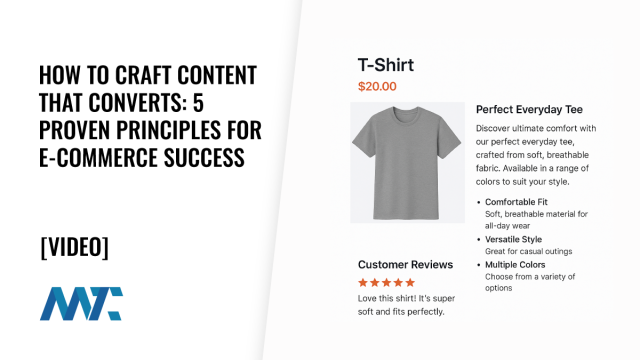In the crowded world of online stores, content can make the difference between a casual browser and a paying customer. High-converting e-commerce content isn’t just about describing a product – it’s about structuring information to match how users scan, read, and engage with pages.
From product descriptions to blog articles, effective content uses smart structure, psychological cues, targeted messaging, clear readability, persuasive language, and strong visual hierarchy to guide users toward conversion.
Table of Contents
Structure and Visual Hierarchy in Page DesignReadability and Scannability of TextPersuasive Language and Copywriting TechniquesPsychological Triggers and Trust SignalsAudience Targeting and PersonalizationKey Takeaways
Structure and Visual Hierarchy in Page Design
E-commerce shoppers often make split-second judgments about a site, so how content is structured on the page is critical. A clear visual hierarchy ensures that the most important information grabs attention first. Users typically start at the upper-left area of a page and then scan outward in an F-shaped pattern.
Prominent headlines should appear at the top of the page to immediately communicate the product value or key message. Critical information like product name, pricing, and calls to action (CTAs) should be visible above the fold, where attention is strongest. The layout must be organized into intuitive sections, such as product features, reviews, or FAQs, enabling visitors to navigate efficiently.
Information-heavy sections benefit from bullet points with bolded labels and short explanations that align with how users scan the left margin. CTA buttons should be prominent and visually distinct through contrasting colors and sufficient whitespace.
Typical Layout
Small product image below lengthy text, unclear CTA placement.
Optimized Layout
The top left has a large product image, a bold title and price beside it, and a visible and distinct CTA button.
Readability and Scannability of Text
Most e-commerce visitors skim content, so pages must be readable at a glance. Text should be concise, and long, dense paragraphs should be avoided. The ideal reading level is between the fifth and eighth grades to ensure clarity across a broad audience.
Use short paragraphs, descriptive subheadings, and highlighted phrases to simplify skimming. Bulleted lists can break down complex points or features, especially on product pages.
Mobile responsiveness is critical. Content must be designed to flow well on smaller screens, with readable fonts, appropriate spacing, and touch-friendly formatting. Avoid jargon or overly technical descriptions.
Typical Copy
Our revolutionary new gel formula, with its patented nano-delivery system, ensures optimal dermal penetration.
Optimized Copy
Fast-absorbing gel that gives your skin a healthy glow in minutes.
Persuasive Language and Copywriting Techniques
Content that converts doesn’t just inform – it motivates. Effective e-commerce copy emphasizes how a product solves a problem or improves the shopper’s life.
Rather than listing features, focus on how those features deliver value. CTAs should use strong, actionable language like Add to Cart or Unlock 20% Off Today. Descriptive and sensory words engage emotions and imagination, making content more persuasive.
Storytelling can also enhance relevance. Paint a brief picture or use a real-world scenario to help customers envision themselves using the product. Always aim for clarity and credibility by backing up claims with specifics or user testimonials.
Typical Copy
Includes a 5000 mAh battery.
Optimized Copy
Stay powered all day with the 5000 mAh battery.
Psychological Triggers and Trust Signals
The best e-commerce content combines psychological principles to reduce friction and inspire confidence. Social proof is a cornerstone – showcasing ratings, reviews, and testimonials signals product satisfaction and builds credibility.
Urgency and scarcity work by nudging users toward faster decisions. Messages like Only 3 left in stock or countdown timers for sales can dramatically increase conversions. Trust signals, such as SSL certificates, payment provider badges, or return policy icons, reassure customers that their transaction is secure.
Reciprocity – giving something of value, like a free guide, discount, or sample – increases the likelihood of conversion. Micro-conversions, such as adding to a wishlist or signing up for a newsletter, also build psychological investment.
Typical Message
In stock.
Optimized Message
Only 3 left – order soon!
Audience Targeting and Personalization
Content performs best when directly aligned with the shopper’s interests, context, and intent. Begin by defining your customer personas. Are they outdoor adventurers, working parents, or budget-conscious students? Your language, visuals, and priorities should reflect their world.
Deliver value up front through how-to guides, product comparisons, or relevant blog content. Personalization tools can dynamically adjust what content is shown based on user data – recent browsing history, geolocation, or campaign source.
Segmentation across channels can make outreach more effective. Email campaigns, social ads, or on-site banners can all be customized for new vs. returning users, seasonal buyers, or high-value prospects.
Typical Copy
Our shoes are great for any occasion.
Optimized Copy
Perfect for city walks or weekend getaways – these shoes cushion every step.
Key Takeaways
Use a clear structure: Organize each page with intuitive placement of headlines, images, and CTAs based on natural user scanning patterns.
Write for readability: Keep the language plain and paragraphs short so users can grasp your message even if they’re skimming.
Make it persuasive: Lead with benefits, use emotional and descriptive language, and craft specific and inviting CTAs.
Apply psychology: Build trust with reviews and badges, and prompt action using urgency, scarcity, and risk-reduction techniques.
Tailor to your audience: Use personalized content that aligns with your customers’ goals and context to speak directly to different customer segments.
By aligning content with how users scan, think, and decide, e-commerce brands can turn product pages and blog posts into powerful sales tools. The right content doesn’t just inform – it inspires action.
©2025 DK New Media, LLC, All rights reserved | Disclosure
Originally Published on Martech Zone: How to Craft Content That Converts: 5 Proven Principles for E-Commerce Success

